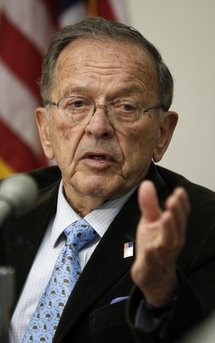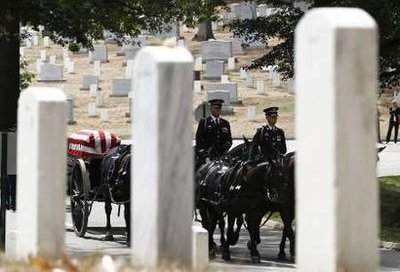August 10, 2010:
Former Senator Ted Stevens, who died in a plane crash, was known as the longest-serving Republican in US Senate history, “Alaskan of the Century,” or simply “Uncle Ted.”
The Ted Stevens plane crash occurred Monday night in southwest Alaska.
Over his 40 years in the Senate, Stevens delivered billions of dollars in aid to his home state. He also muscled through laws that opened the Trans-Alaska Pipeline in 1973 and reined in foreign fishing fleets that threatened nearby fisheries. But, in a rare defeat, he failed to overcome opposition from environmentalists to opening the Arctic National Wildlife Refuge (ANWR) to exploration and drilling.
“When I came to the Senate, Alaska had been a state for less than a decade. We were then more of an impoverished territory than a full-fledged state,” Stevens said in his farewell address to the Senate on November 20, 2008.
“Where there was nothing but tundra and forest, today there are now airports, roads, ports, water, and sewer systems, hospitals, clinics, communications networks, research labs, and much, much more,” he added.
With Stevens’s clout, including a stint as chair of the powerful Appropriations Committee, Alaska consistently ranked No. 1 in the “pork per capita” ranking, an annual production of Citizens Against Government Waste. The Washington-based public-interest group made Stevens its poster boy for wasteful, pork-barrel spending.
Stevens, in turn, railed at critics who he said failed to understand the special needs of his vast, underserviced rural state. In a fiery floor speech on October 20, 2005, Stevens threatened to resign from the Senate if his colleagues approved an amendment to cut money for a $453 million measure to fund a bridge from Ketchikan, Alaska, to an island with some 50 residents – dubbed by critics the “Bridge to Nowhere.”
“I will put the Senate on notice – and I don’t kid people: If the Senate decides to discriminate against our state and take money only from our state, I will resign from this body,” he said. He won that Senate showdown, but Congress subsequently stripped the earmark out of the omnibus spending bill for fiscal year 2006, although it didn’t decrease Alaska’s overall funding. Sarah Palin (R) canceled the project in 2007 when she was governor of Alaska.
In the midst of a reelection campaign in July 2008, Stevens was indicted by a federal grand jury for failing to report corporate gifts and was convicted. He then lost his reelection bid. In April 2009, the Justice Department dropped all charges against Stevens, citing prosecutorial misconduct.
No stranger to aviation, Stevens flew support missions for the Flying Tigers of the 14th Air Force during World War II, for which he won the Distinguished Flying Cross. He was elected to the Alaska House in 1964 and appointed to the US Senate in 1968 to fill the unexpired term of Alaska’s first senator, Democrat Bob Bartlett. He barely survived an airline crash in 1978, which took the life of his first wife, Ann, and nearly ended his career.
“But my dear wife, Catherine, entered my life in 1980, and, joined by my six children – Susan, Beth, Ted, Walter, Ben, and Lily – and my 11 grandchildren, my family has given me love, support, and sacrifice, which made my continued career here in the Senate possible and gave it meaning,” he said in his 2008 farewell speech.
Plane crashes in Alaska, where travel by small private aircraft is a necessity to cover the expansive state, happen often – and have taken the lives of other public officials. In 1972, House majority leader Hale Boggs (D) of Louisiana and Representative Nick Begich (D) of Alaska were presumed dead after their plane went missing during a campaign flight in Alaska. Of 64 aviation accidents in the state in the past 20 years, 22 have resulted in fatalities, according to the Flight Safety Foundation’s aviation-safety database.
“In the history of our country, no one man has done more for one state than Ted Stevens,” said Republican leader Mitch McConnell in a statement. “His commitment to the people of Alaska and his nation spanned decades, and he left a lasting mark on both.”
Sen. Mary Landrieu (D) of Louisiana, who often joined Stevens in the hit lists of public-interest groups opposed to pork spending, said in a statement: “Ted always said, ‘To hell with politics. Do what is best for Alaska.’ He never apologized for fighting for his state, and Alaska is better for it today.”
29 September 2010:
Former Alaska Senator Ted Stevens, who served in the Senate longer than any Republican in history, was buried with full military honors Tuesday at Arlington National Cemetery.
A caisson led by six horses and followed by an eight-man honor guard escorted the body to the burial site, where a firing party fired three rifle volleys and four F-22 Raptors did a flyover as a bugler played “Taps.”
Stevens was one of five people killed in an Aug. 9 plane crash in southwest Alaska. He was 86.
Stevens was a World War II veteran and was awarded the Distinguished Flying Cross. He went into public service before Alaska became a state in 1959 and was appointed to the Senate in December 1968.
Stevens lost his seat in the election of 2008, when he was convicted on corruption charges shortly before Election Day. A federal judge later threw out the verdict because of misconduct by federal prosecutors.
The Democrat who defeated Stevens in that election, Mark Begich, was among the mourners. Receiving the flag from General Norton A. Schwartz, Chief of Staff of the Air Force, was Stevens’ widow, Catherine Stevens.
During his four decades in the Senate Stevens headed the powerful Appropriations committee and attained the rank of president pro tempore, third in rank in succession to the president.
“Ted left exemplary footprints in the sands of time,” Senate Chaplain Barry Black told the gathering. “I have not met anyone who loved his country more than Ted Stevens and I know I’ve not met anyone who loved Alaska more.”
Late Monday the Senate approved legislation to name a mountain and part of an ice field after him.
What is now known as South Hunter Peak, a mountain located in Denali National Park and Preserve just south of Mount McKinley, will become Stevens Peak after the House passes the bill and the president signs it into law.
“The Senate will be thinking of Ted Stevens today,” Republican leader Mitch McConnell of Kentucky said in a speech on the Senate floor. His colleagues admired and even feared Stevens, McConnell said. “Alaskans loved him without any qualifications. To them he was just ‘Uncle Ted.'”
Stevens was also honored at ceremonies in Alaska in August attended by Vice President Joe Biden, several dozen lawmakers and thousands of Alaskans.
Theodore Fulton “Ted” Stevens (November 18, 1923 – August 9, 2010)[1][2] was a United States Senator from Alaska, serving from December 24, 1968, until January 3, 2009, and thus the longest-serving Republican senator in history. He was President pro tempore in the 108th and 109th Congresses from January 3, 2003, to January 3, 2007, and the third senator to hold the title of President pro tempore emeritus.
Stevens served for six decades in the American public sector, beginning with his service in World War II. In the 1950s, he held senior positions in the Eisenhower Interior Department. He played key roles in legislation that shaped Alaska’s economic and social development, including the Alaska Native Claims Settlement Act, the Trans-Alaska Pipeline Authorization Act, the Alaska National Interest Lands Conservation Act, and the Magnuson-Stevens Fishery Conservation and Management Act. He was also known for his sponsorship of the Amateur Sports Act of 1978, which resulted in the establishment of the United States Olympic Committee.
In 2008, Stevens was embroiled in a federal corruption trial as he ran for re-election to the Senate. He was found guilty, and eight days later was narrowly defeated at the polls. Six months later his conviction was dismissed on grounds of gross prosecutorial misconduct.
On August 9, 2010, Stevens died in a plane crash while en route to a private lodge.
Stevens was born November 18, 1923, in Indianapolis, Indiana, the third of four children, in a small cottage built by his paternal grandfather after the marriage of his parents, Gertrude S. (née Chancellor) and George A. Stevens. The family later lived in Chicago, where George Stevens was an accountant before the stock market crash of 1929 instigated the Great Depression, ending his job. Around this time, when Ted Stevens was six years old, his parents divorced, and Stevens and his three siblings went back to Indianapolis to live with their paternal grandparents, followed shortly thereafter by their father, who developed problems with his eyes and went blind for several years. Stevens’ mother moved to California and sent for Stevens’ siblings as she could afford to, but Stevens stayed in Indianapolis helping to care for his father and a mentally disabled cousin, Patricia Acker, who also lived with the family. The only adult in the household with a job was Stevens’ grandfather. Stevens helped to support the family by working as a newsboy, and would later remember selling many newspapers on March 1, 1932, when newspaper headlines blared the news of the Lindbergh kidnapping.
In 1934, Stevens’ grandfather punctured a lung in a fall down a tall flight of stairs, contracted pneumonia, and died. Stevens’ father, George, died in 1957 in Tulsa, Oklahoma, of lung cancer. Stevens and his cousin Patricia moved to Manhattan Beach, California, to live with Patricia’s mother, Gladys Swindells. Stevens attended Redondo Union High School, participating in extracurricular activities including working on the school newspaper and becoming a member of a student theater group – a service society affiliated with the YMCA – and, during his senior year, the Lettermen’s Society. Stevens also worked at jobs before and after school, but still had time for surfing with his friend Russell Green, son of the president of Signal Gas and Oil Company, who remained a close friend throughout Stevens’ life.
After graduating from high school in 1942, Stevens enrolled at Oregon State University to study engineering, attending for a semester. With World War II in progress, Stevens attempted to join the Navy and serve in Naval Aviation, but failed the vision exam. He corrected his vision through a course of prescribed eye exercises, and in 1943 he was accepted into an Army Air Force Air Cadet program at Montana State College. After scoring near the top of an aptitude test for flight training, Stevens was transferred to preflight training in Santa Ana, California; and received his wings early in 1944.
Stevens served in the China-Burma-India theater with the Fourteenth Air Force Transport Section, which supported the “Flying Tigers”, from 1944 to 1946. He and other pilots in the transport section flew C-46 and C-47 transport planes, often without escort, mostly in support of Chinese units fighting the Japanese. Stevens received the Distinguished Flying Cross for flying behind enemy lines, the Air Medal, and the Yuan Hai Medal awarded by the Chinese Nationalist government. He was discharged from the Army Air Forces in March 1946.
After the war, Stevens attended the University of California, Los Angeles (UCLA), where he earned a Bachelor of Arts degree in political science in 1947. While at UCLA, he was a member of Delta Kappa Epsilon fraternity (Theta Rho chapter). He applied to law school at Stanford University and the University of Michigan, but on the advice of his friend Russell Green’s father to “look East,” he applied to Harvard Law School, which he ended up attending. Stevens’ education was partly financed by the G.I. Bill; he made up the difference by selling his blood, borrowing money from an uncle, and working several jobs – including one as a bartender in Boston. During the summer of 1949, Stevens was a research assistant in the office of the U.S. Attorney for the Southern District of California, now the Central District of California.
While at Harvard, Stevens wrote a paper on maritime law which received honorable mention for the Addison Brown prize, a Harvard Law School award made for the best essay by a student on a subject related to private international law or maritime law. The essay later became a Harvard Law Review article whose scholarship Justice Jay Rabinowitz of the Alaska Supreme Court praised 45 years later, telling the Anchorage Daily News in 1994 that the high court had issued a recent opinion citing the article. Stevens graduated from Harvard Law School in 1950.
After graduation, Stevens went to work in the Washington, D.C., law offices of Northcutt Ely. Twenty years earlier Ely had been executive assistant to Secretary of the Interior Ray Lyman Wilbur during the Hoover administration, and by 1950 headed a prominent law firm specializing in natural resources issues. One of Ely’s clients, Emil Usibelli, founder of the Usibelli Coal Mine in Healy, Alaska, was trying to sell coal to the military, and Stevens was assigned to handle his legal affairs.
Stevens and his wife, Catherine Ann Chandler.Early in 1952, Stevens married Ann Mary Cherrington, a Democrat and the adopted daughter of University of Denver chancellor Ben Mark Cherrington. She had graduated from Reed College in Portland, Oregon, and during Truman’s administration had worked for the State Department.
On December 4, 1978, the crash of a Learjet 25C at Anchorage International Airport killed five people. Ted Stevens survived; his wife, Ann, did not. The building which houses the Alaska chapter of the American Red Cross at 235 East 8th Avenue in Anchorage is named the Ann Stevens Building in her honor.
Stevens and his first wife, Ann, had three sons: Ben, Walter, and Ted; and two daughters: Susan and Beth. Democratic Governor Tony Knowles appointed Ben to the Alaska Senate in 2001, where he served as the president of the state senate until the fall of 2006.
Ted Stevens remarried in 1980; he and his second wife, Catherine, had a daughter, Lily.
Stevens’s last home was in Girdwood, a ski resort community located within the extreme southern boundaries of Anchorage.
Stevens was a survivor of prostate cancer and had publicly disclosed his cancer. He was nominated for the first Golden Glove Awards for Prostate Cancer by the National Prostate Cancer Coalition (NPCC). He advocated the creation of the Congressionally Directed Medical Research Program for Prostate Cancer at the Department of Defense which has funded nearly $750 million for prostate cancer research. Stevens was a recipient of the Presidential Citation by the American Urological Association for significantly promoting urology causes.
In 1952, while still working for Norcutt Ely, Stevens volunteered for the presidential campaign of Dwight D. Eisenhower, writing position papers for the campaign on western water law and lands. By the time Eisenhower won the election that November, Stevens had acquired contacts who told him, “We want you to come over to Interior.” Stevens left his job with Ely, but a job in the Eisenhower administration didn’t come through as a result of a temporary hiring freeze instituted by Eisenhower in an effort to reduce spending.
Instead, Stevens was offered a job with the Fairbanks, Alaska, law firm of Emil Usibelli’s Alaska attorney, Charles Clasby, whose firm – Collins and Clasby – had just lost one of its attorneys. Stevens and his wife had met and liked both Usibelli and Clasby, and decided to make the move. Loading up their 1947 Buick and traveling on a $600 loan from Clasby, they drove across country from Washington, D.C., and up the Alaska Highway in the dead of winter, arriving in Fairbanks in February 1953. Stevens later recalled kidding Governor Walter Hickel about the loan. “He likes to say that he came to Alaska with 37 cents in his pocket,” he said of Hickel. “I came $600 in debt.” Ann Stevens recalled in 1968 that they made the move to Alaska “on a six-month trial basis.”
In Fairbanks, Stevens cultivated the city’s Republican establishment. He befriended conservative newspaper publisher C.W. Snedden, who had purchased the Fairbanks Daily News-Miner in 1950. Snedden’s wife Helen later recalled that her husband and Stevens were “like father and son.” “The only problem Ted had was that he had a temper,” she told a reporter in 1994, crediting her husband with helping to steady Stevens “like you would do with your children” and with teaching Stevens the art of diplomacy.
Stevens had been with Charles Clasby’s law firm for six months when Bob McNeally, a Democrat appointed as U.S. Attorney for Fairbanks during the Truman administration, informed U.S. District Judge Harry Pratt that he would be resigning effective August 15, 1953, having already delayed his resignation by several months at the request of Justice Department officials newly appointed by Eisenhower. The latter had asked McNeally to delay his resignation until Eisenhower could appoint a replacement. Despite Stevens’ short tenure as an Alaska resident and his relative lack of trial or criminal law experience, Pratt asked Stevens to serve in the position until Eisenhower acted. Stevens agreed. “I said, ‘Sure, I’d like to do that,’ ” Stevens recalled years later. “Clasby said, ‘It’s not going to pay you as much money, but, if you want to do it, that’s your business.’ He was very pissed that I decided to go.” Most members of the Fairbanks Bar Association were outraged at the appointment of a newcomer, and members in attendance at the association’s meeting that December voted to support Carl Messenger for the permanent appointment, an endorsement seconded by the Alaska Republican Party Committee for the Fairbanks-area judicial division. However, Stevens was favored by Attorney General Herbert Brownell, by Senator William F. Knowland of California, and by the Republican National Committee, (Alaska itself had no Senators at this time, as it was still a territory). Eisenhower sent Stevens’ nomination to the U.S. Senate, which confirmed him on March 30, 1954.
Stevens soon gained a reputation as an active prosecutor who vigorously prosecuted violations of federal and territorial liquor, drug, and prostitution laws,[14] characterized by Fairbanks area homesteader Niilo Koponen (who later served in the Alaska State House of Representatives from 1982–1991) as “this rough tough shorty of a district attorney who was going to crush crime.”[23] Stevens sometimes accompanied U.S. Marshals on raids. As recounted years later by Justice Jay Rabinowitz, “U.S. marshals went in with Tommy guns and Ted led the charge, smoking a stogie and with six guns on his hips.” However, Stevens himself has said the colorful stories spread about him as a pistol-packing D.A. were greatly exaggerated, and recalled only one incident when he carried a gun: on a vice raid to the town of Big Delta about 75 miles (121 km) southeast of Fairbanks, he carried a holstered gun on a marshal’s suggestion.
Stevens also became known for his explosive temper, which was focused particularly on a criminal defense lawyer named Warren A. Taylor who would later go on to become the Alaska Legislature’s first Speaker of the House in the First Alaska State Legislature. “Ted would get red in the face, blow up and stalk out of the courtroom,” a former court clerk later recalled of Stevens’ relationship with Taylor.
In 1956, in a trial which received national headlines, Stevens prosecuted Jack Marler, a former Internal Revenue Service agent accused of failing to file tax returns. Marler’s first trial, which was handled by a different prosecutor, had ended in a deadlocked jury and a mistrial. For the second trial, Stevens was up against Edgar Paul Boyko, a flamboyant Anchorage attorney who built his defense of Marler on the theory of no taxation without representation, citing the Territory of Alaska’s lack of representation in the U.S. Congress. As recalled by Boyko, his closing argument to the jury was a rabble-rousing appeal for the jury to “strike a blow for Alaskan freedom,” claiming that “this case was the jury’s chance to move Alaska toward statehood.” Boyko remembered that “Ted had done a hell of a job in the case,” but Boyko’s tactics paid off, and Marler was acquitted on April 3, 1956. Following the acquittal, Stevens issued a statement saying, “I don’t believe the jury’s verdict is an expression of resistance to taxes or law enforcement or the start of a Boston Tea Party. I do believe, however, that the decision will be a blow to the hopes for Alaska statehood.”
In March 1956, Stevens’ friend Elmer Bennett, legislative counsel in the Department of the Interior, was promoted by Secretary of the Interior Douglas McKay to the Secretary’s office. Bennett successfully lobbied McKay to replace him in his old job with Stevens, and Stevens returned to Washington, D.C., to take up the position. By the time he arrived in June 1956, McKay had resigned in order to run for the U.S. Senate from his home state of Oregon and Fred Andrew Seaton had been appointed to replace him. Seaton, a newspaper publisher from Nebraska, was a close friend of Fairbanks Daily News-Miner publisher C.W. Snedden, and in common with Snedden was an advocate of Alaska statehood,unlike McKay, who had been lukewarm in his support. Seaton asked Snedden if he knew any Alaskan who could come to Washington, D.C. to work for Alaska statehood; Snedden replied that the man he needed—Stevens—was already there working in the Department of the Interior. The fight for Alaska statehood became Stevens’ principal work at Interior. “He did all the work on statehood,” Roger Ernst, Seaton’s assistant secretary for public land management, later said of Stevens. “He wrote 90 percent of all the speeches. Statehood was his main project.”[26] A sign on Stevens’ door proclaimed his office “Alaskan Headquarters” and Stevens became known at the Department of the Interior as “Mr. Alaska.”
Efforts to make Alaska a state had been going on since 1943, and had nearly come to fruition during the Truman administration in 1950 when a statehood bill passed in the U.S. House of Representatives, only to die in the Senate.The national Republican Party opposed statehood for Alaska, in part out of fear that Alaska would elect Democrats to Congress. At the time Stevens arrived in the Washington, D.C., to take up his new job, a constitutional convention to write an Alaska constitution had just been concluded on the campus of the University of Alaska in Fairbanks. The 55 delegates also elected three unofficial representatives – all Democrats – as unofficial delegates to Congress: Ernest Gruening and William Egan as U.S. Senators and Ralph Rivers as U.S. representative.
President Eisenhower, a Republican, regarded Alaska as too large and sparsely populated to be economically self-sufficient as a state, and furthermore saw statehood as an obstacle to effective defense of Alaska should the Soviet Union seek to invade it. Eisenhower was especially worried about the sparsely populated areas of northern and western Alaska. In March 1954, he had drawn a line on a map indicating his opinion of the portions of Alaska which he felt ought to remain in federal hands even if Alaska were granted statehood.
Seaton and Stevens worked with Gen. Nathan Twining, chairman of the Joint Chiefs of Staff, who had served in Alaska; and Jack L. Stempler, a top Defense Department attorney, to create a compromise that would address Eisenhower’s concerns. Much of their work was conducted in a hospital room at Walter Reed Army Hospital, where Seaton was being treated for back problems.[26] Their work concentrated on refining the line on the map that Eisenhower had drawn in 1954, one which became known as the PYK Line after three rivers – the Porcupine, Yukon, and Kuskokwim – whose courses defined much of the line. The PYK Line was the basis for Section 10 of the Alaska Statehood Act, which Stevens wrote.[26] Under Section 10, the land north and west of the PYK Line – which included the entirety of Alaska’s North Slope, the Seward Peninsula, most of the Yukon-Kuskokwim Delta, the western portions of the Alaska Peninsula, and the Aleutian and Pribilof Islands—would be part of the new state, but the President would be granted emergency powers to establish special national defense withdrawals in those areas if deemed necessary. “It’s still in the law but it’s never been exercised,” Stevens later recollected. “Now that the problem with Russia is gone, it’s surplusage. But it is a special law that only applies to Alaska.”
Stevens also took part – illegally – in lobbying for the statehood bill, working closely with the Alaska Statehood Committee from his office at Interior. Stevens hired Margaret Atwood, daughter of Anchorage Times publisher Robert Atwood,[26] who was chairman of the Alaska Statehood Committee, to work with him in the Interior Department. “We were violating the law,” Stevens told a researcher in an October 1977 oral history interview for the Eisenhower Library. “[W]e were lobbying from the executive branch, and there’s been a statute against that for a long time…. We more or less, I would say, masterminded the House and Senate attack from the executive branch.” Stevens and the younger Atwood created file cards on members of Congress based on “whether they were Rotarians or Kiwanians or Catholics or Baptists and veterans or loggers, the whole thing,” Stevens said in the 1977 interview. “And we’d assigned these Alaskans to go talk to individual members of the Senate and split them down on the basis of people that had something in common with them.” The lobbying campaign extended to presidential press conferences. “We set Ike up quite often at press conferences by planting questions about Alaska statehood,” Stevens said in the 1977 interview. “We never let a press conference go by without getting someone to try to ask him about statehood.” Newspapers were also targeted, according to Stevens. “We planted editorials in weeklies and dailies and newspapers in the district of people we thought were opposed to us or states where they were opposed to us so that suddenly they were thinking twice about opposing us.”
The Alaska Statehood Act became law with Eisenhower’s signature on July 7, 1958, and Alaska formally was admitted to statehood on January 3, 1959, when Eisenhower signed the Alaska Statehood Proclamation.
After returning to Alaska, Stevens practiced law in Anchorage and became a member of Operation Rampart, a group in favor of building the Rampart Dam, a hydroelectric project on the Yukon River. Elected to the Alaska House of Representatives in 1964, he became House majority leader in his second term.
In 1968, Stevens ran for the Republican nomination for U.S. Senate, but lost in the primary to Anchorage Mayor Elmer E. Rasmuson. Rasmuson lost the general election to Democrat Mike Gravel. In December 1968, after the death of Alaska’s other senator, Democrat Bob Bartlett, Governor Wally Hickel appointed Stevens to the U.S. Senate. Since Gravel took office 10 days after Stevens did, Stevens was Alaska’s senior senator for all but 10 days of his forty-year tenure in the Senate – a unique distinction.
In a special election in 1970, Stevens won the right to finish the remainder of Bartlett’s term. He won the seat in his own right in 1972, and was reelected in 1978, 1984, 1990, 1996 and 2002 elections. His final term expired in January 2009. Since his first election to a full term in 1972, Stevens never received less than 66% of the vote before his 2008 defeat for re-election.
Stevens lost his Senate re-election bid in 2008. He won the Republican primary in August and was defeated by Anchorage Mayor Mark Begich in the general election.
Stevens served as the Assistant Republican Leader (Whip) from 1977 to 1985. In 1994, after the Republicans took control of the Senate, Stevens was appointed Chairman of the Senate Rules Committee. Stevens became the Senate’s President Pro Tempore when Republicans regained control of the chamber as a result of the 2002 mid-term elections, during which the previous most senior Republican senator and former President Pro Tempore Strom Thurmond retired.
After Howard Baker retired in 1984, Stevens sought the position of Republican (and then-Majority) leader, running against Bob Dole, Dick Lugar, Jim McClure and Pete Domenici. As Republican whip, Stevens was theoretically the favorite to succeed Baker, but lost to Dole in a fourth ballot.
Stevens chaired the Senate Appropriations Committee from 1997 to 2005, except for the 18 months when Democrats controlled the chamber. The chairmanship gave Stevens considerable influence among fellow Senators, who relied on him for home-state project funds. Even before becoming chairman of the Appropriations Committee, Stevens secured large sums of federal money for the state of Alaska. Due to Republican Party rules that limited committee chairmanships to six years, Stevens gave up the Appropriations gavel at the start of the 109th Congress, in January 2005.
He chaired the United States Senate Committee on Commerce, Science and Transportation during the 109th Congress, becoming the committee’s ranking member after the Democrats regained control of the Senate for the 110th Congress. He resigned his ranking-member position on the committee due to his indictment.
At various times, Stevens also served as Chairman of the Senate Governmental Affairs Committee, the Senate Ethics Committee, the Arms Control Observer Group, and the Joint Committee on the Library of Congress.
Due to Stevens’ long tenure and that of the state’s sole congressman, Don Young, Alaska was considered to have clout in national politics well beyond its small population (the state was long the smallest in population and is currently 47th, ahead of only Wyoming, North Dakota and Vermont).
On June 28, 2006, the Senate commerce committee was in the final day of three days of hearings, during which the Committee members considered over 200 amendments to an omnibus telecommunications bill. Senator Stevens authored the bill, S. 2686, the Communications, Consumer’s Choice, and Broadband Deployment Act of 2006.
Senators Olympia Snowe (R-ME) and Byron Dorgan (D-ND) cosponsored and spoke on behalf of an amendment that would have inserted strong network neutrality mandates into the bill. In between speeches by Snowe and Dorgan, Stevens gave a vehement 11-minute speech using colorful language to explain his opposition to the amendment. Stevens referred to the Internet as “not a big truck,” but a “series of tubes” that could be clogged with information. Stevens also may have confused the terms Internet and e-mail. Soon after, Stevens’ interpretation of how the Internet works became a topic of amusement and ridicule in the blogosphere. The phrases “the Internet is not a big truck” and “series of tubes” became internet memes and were prominently featured on U.S. television shows including Comedy Central’s The Daily Show. In obituaries, he was remembered however as the “grandfather of net neutrality”
Cnet Journalist Declan McCullagh called “series of tubes” an “entirely reasonable” metaphor for the Internet, noting that some computer operating systems use the term ‘pipes’ to describe interprocess communication.
Stevens escorts former first lady Nancy Reagan at the Ronald W. Reagan Missile Defense Site dedication ceremony, April 10, 2006Stevens was a long-standing proponent of logging and championed a plan that would allow 2,400,000 acres (9,700 km2) of roadless old growth forest to be clear-cut. Stevens stated that this would revive Alaska’s timber industry and bring jobs to unemployed loggers; however, the proposal would mean that thousands of miles of roads would be constructed at the expense of the United States Forest Service, judged to cost taxpayers $200,000 per job created.
Stevens considered himself pro-choice. According to On the Issues[44] and NARAL,[45] Ted Stevens has a mildly pro-life voting record, despite some notable pro-choice votes.
However, as a former member of the moderate Republican Main Street Partnership, Stevens supported human embryonic stem cell research.
Stevens, once an avowed critic of anthropogenic climate change, began actively supporting legislation to combat climate change in early 2007. “Global climate change is a very serious problem for us, becoming more so every day,” he said at a Senate hearing, adding that he was “concerned about the human impacts on our climate.”
However, in September 2007, Stevens said:
We’re at the end of a long, long term of warming. 700 to 900 years of increased temperature, a very slow increase. We think we’re close to the end of that. If we’re close to the end of that, that means that we’ll starting getting cooler gradually, not very rapidly, but cooler once again and stability might come to this region for a period of another 900 years.
This article’s Criticism or Controversy section(s) may mean the article does not present a neutral point of view of the subject. It may be better to integrate the material in those sections into the article as a whole.
As a Senator, Ted Stevens was subject to criticism:
Citizens Against Government Waste has accused Stevens of pork barrel politics and keeps a list of his projects.
Additionally, he received criticism for introducing a bill in January 2007 that would heavily restrict access to social networking sites from public schools and libraries. Sites falling under the language of this bill could include MySpace, Facebook, Digg, Wikipedia and Reddit.
In 2007, Stevens added $3.5 million into a Senate spending bill to help finance an airport to serve a remote Alaskan island.[55] The airstrip would connect the roughly 100 permanent residents of Akutan, but the biggest beneficiary is the Seattle-based Trident Seafoods Corp. that operates “one of the world’s largest seafood processing plants on the volcanic island in the Aleutians.”[55] In December 2006, a federal grand jury investigating political corruption in Alaska ordered Trident and other seafood companies to produce documents about ties to the senator’s son, former Alaska Fisheries Marketing Board Chairman Ben Stevens.[55] Trident’s chief executive, Charles Bundrant, was a longtime supporter of Sen. Stevens, and Bundrant with his family contributed $17,300 since 1995 to Ted Stevens’ political campaigns and $10,800 to his leadership PAC while Bundrant also gave $55,000 to the National Republican Senatorial Campaign Committee.
In December 2003, the Los Angeles Times reported that Stevens had taken advantage of lax Senate rules to use his political influence to obtain a large amount of his personal wealth. According to the article, while Stevens was already a millionaire “thanks to investments with businessmen who received government contracts or other benefits with his help,” the lawmaker who is in charge of $800 billion a year, writes “preferences he wrote into law,” from which he then benefits.
Stevens’ home in Girdwood, AlaskaMay 29, 2007, the Anchorage Daily News reported that the FBI and a federal grand jury were investigating an extensive remodeling project at Stevens’ home in Girdwood. Stevens’ Alaska home was raided by the FBI and IRS on July 30, 2007.[57] The remodeling work doubled the size of the modest home. Public records show that the house was 2,471 square feet (230 m2) after the remodeling and that the property was valued at $271,300 in 2003, including a $5,000 increase in land value.[58] The remodel in 2000 was organized by Bill Allen, a founder of the VECO Corporation – an oil-field service company – and has been estimated to have cost VECO and the various contractors $250,000 or more.[59] However, the residential contractor who finished the renovation for VECO, Augie Paone, “believes the [Stevens’] remodeling could have cost – if all the work was done efficiently – around $130,000 to $150,000, close to the figure Stevens cited last year.”[60] The Stevens paid $160,000 for the renovations “and assumed that covered everything.”
In June, the Anchorage Daily News reported that a federal grand jury in Washington, D.C., heard evidence in May about the expansion of Stevens’ Girdwood home and other matters connecting Stevens to VECO. In mid-June, FBI agents questioned several aides who work for Stevens as part of the investigation. In July, Washingtonian magazine reported that Stevens had hired “Washington’s most powerful and expensive lawyer”, Brendan Sullivan Jr., in response to the investigation.[64] In 2006, during wiretapped conversations with Bill Allen, Stevens expressed worries over potential misunderstandings and legal complications arising from the sweeping federal investigations into Alaskan politics. On the witness stand, “Allen testified that VECO staff who had worked on his own house had charged ‘way too much,’ leaving him uncertain how much to invoice Stevens for when he had his staff work on the senator’s house … that he would be embarrassed to bill Stevens for overpriced labor on the house, and said he concealed some of the expense.”
The Justice Department is also examining whether federal funds that Stevens steered to the Alaska SeaLife Center may have enriched a former aide.Currently the United States Department of Commerce and the Interior Department’s inspector general are investigating “how millions of dollars that Stevens (R-Alaska) obtained for the nonprofit Alaska SeaLife Center were spent.” According to CNN, “Among the questions is how about $700,000 of nearly $4 million directed to the National Park Service wound up being paid to companies associated with Trevor McCabe, a former legislative director for Stevens.”
In September 2007, The Hill reported that Stevens had “steered millions of federal dollars to a sportfishing industry group founded by Bob Penney, a longtime friend.” In 1998, Stevens invested $15,000 in a Utah land deal managed by Penney; in 2004, Stevens sold his share of the property for $150,000.
On July 29, 2008, Stevens was indicted by a federal grand jury on seven counts of failing to properly report gifts, a felony, and found guilty at trial three months later (October 27, 2008). The charges relate to renovations to his home and alleged gifts from VECO Corporation, claimed to be worth more than $250,000. The indictment followed a lengthy investigation by the Federal Bureau of Investigation (FBI) and the Internal Revenue Service (IRS) for possible corruption by Alaskan politicians and was based on Stevens’ relationship with Bill Allen. Allen, then an oil service company executive, had earlier pleaded guilty – with sentencing suspended pending his cooperation in gathering evidence and giving testimony in other trials – to bribing several Alaskan state legislators, including a disputed claim about Stevens’ son, former State Senator Ben Stevens. Stevens declared, “I’m innocent,” and pleaded not guilty to the charges in a federal district court on July 31, 2008. Stevens asserted his right to a speedy trial so that he could have the opportunity to clear his name promptly and requested that the trial be held before the 2008 election.
US District Court Judge in Washington DC Emmet G. Sullivan, on October 2, 2008, denied the mistrial petition of Stevens’ chief counsel, Brendan Sullivan, due to allegations of withholding evidence by prosecutors. Thus, the latter were admonished, and would submit themselves for internal probe by the United States Department of Justice. Brady v. Maryland requires prosecutors to give a defendant all information for defense. Judge Sulllivan had earlier admonished the prosecution for sending home to Alaska a witness who might have helped the defense.
The case was prosecuted by Principal Deputy Chief Brenda K. Morris, Trial Attorneys Nicholas A. Marsh and Edward P. Sullivan of the Criminal Division’s Public Integrity Section, headed by Chief William M. Welch II; and Assistant U.S. Attorneys Joseph W. Bottini and James A. Goeke from the District of Alaska.
On October 27, 2008, Stevens was found guilty of all seven counts of making false statements. Stevens was only the fifth sitting senator to be convicted by a jury in U.S. history, and the first since Senator Harrison A. Williams (D-NJ) in 1981[80] (although Senator David Durenberger (R-MN) pled guilty to a felony more recently, in 1995). Stevens faced a maximum penalty of five years per charge.[81] His sentencing hearing was originally arranged February 25, but his attorneys told Judge Emmet Sullivan they would file applications to dispute the verdict by early December.However, it was thought unlikely that he would have seen significant time in prison.
Within a few days of his conviction, Stevens faced bipartisan calls for his resignation. Both parties’ presidential candidates, Barack Obama and John McCain, were quick to call for Stevens to stand down. Obama said that Stevens needed to resign to help “put an end to the corruption and influence-peddling in Washington.”McCain said that Stevens “has broken his trust with the people” and needed to step down—a call echoed by his running mate, Sarah Palin, governor of Stevens’ home state. Senate Minority Leader Mitch McConnell, as well as fellow Republican Senators Norm Coleman, John Sununu and Gordon Smith also called for Stevens to resign. McConnell said there would be “zero tolerance” for a convicted felon serving in the Senate—strongly hinting that he would support Stevens’ expulsion from the Senate unless Stevens resigned first. Late on November 1, Senate Majority Leader Harry Reid confirmed that he would schedule a vote on Stevens’ expulsion, saying that “a convicted felon is not going to be able to serve in the United States Senate.” Had Stevens been expelled after winning election, a special election would have been held to fill the seat through the remainder of the term, until 2014. Some speculated Palin would have tried to run for the Senate via this special election. No sitting Senator has been expelled since the Civil War.
Nonetheless, during a debate with his opponent Mark Begich days after his conviction, Stevens continued to claim innocence. “I have not been convicted. I have a case pending against me, and probably the worst case of prosecutorial misconduct by the prosecutors that is known.” Stevens also cited plans to appeal. Begich went on to defeat Stevens by 3,724 votes.
On November 13, Senator Jim DeMint of South Carolina announced he would move to have Stevens expelled from the Senate Republican Conference (caucus) regardless of the results of the election. Losing his caucus membership would cost Stevens his committee assignments.[94] However, DeMint later decided to postpone offering his motion, saying that while there were enough votes to throw Stevens out, it would be a moot point if Stevens lost his reelection .Stevens ended up losing the Senate race, and on November 20, 2008, gave his last speech to the Senate, which was met with a rare Senate standing ovation.
In February 2009, FBI agent Chad Joy filed a whistleblower affidavit, alleging that prosecutors and FBI agents conspired to withhold and conceal evidence that could have resulted in a verdict of “not guilty.” In his affidavit, Joy alleged that prosecutors intentionally sent a key witness back to Alaska after the witness performed poorly during a mock cross examination. The witness, Rocky Williams, later notified the defense attorneys that his testimony would undercut the prosecution’s claim that his company had spent its own money renovating Sen. Stevens’ house. Joy further alleged that the prosecutors intentionally withheld Brady material including redacted prior statements of a witness, and a memo from Bill Allen stating that Sen. Stevens probably would have paid for the goods and services if asked. Joy further alleged that a female FBI agent had an inappropriate relationship with Allen, who also gave gifts to FBI agents and helped one agent’s relative get a job.
As a result of Joy’s affidavit and claims by the defense that prosecutorial misconduct caused an unfair trial, Judge Sullivan ordered a hearing to be held on February 13, 2009, to determine whether a new trial should be ordered. At the February 13 hearing the judge held the prosecutors in contempt for failing to deliver documents to Stevens’ legal counsel.[98] Judge Sullivan called this conduct “outrageous.”
On behalf of U.S. Attorney General Eric Holder, Paul O’Brien submitted a “Motion of The United States To Set Aside The Verdict And Dismiss The Indictment With Prejudice” in connection with case No. 08-231 early on April 1, 2009. Federal judge Emmet G. Sullivan soon signed the order, and since it occurred prior to sentencing it had the effect of vacating Stevens’ conviction. During the trial, Sullivan expressed concern and anger regarding prosecutorial conduct and related issues. Attorney General Holder was reportedly very angry at the prosecutors’ apparent withholding of exculpatory evidence, and wanted to send a message that prosecutorial misconduct would not be tolerated under his watch. After Sullivan held the prosecutors in contempt, Holder replaced the entire trial team, including top officials in the public integrity section.
The final straw for Holder, according to numerous reports, was the discovery of a previously undocumented interview with Bill Allen, the prosecution’s star witness. Allen stated that the fair market value of the repairs to Stevens’ house was around $80,000 — far less than the $250,000 he said it cost at trial. More seriously, Allen said in the interview that he didn’t recall talking to Bob Persons, a friend of Stevens, regarding the repair bill for Stevens’ house. This directly contradicted Allen’s testimony at trial, in which he claimed Stevens asked him to give Persons a note Stevens sent him asking for a bill on the repair work. At trial, Allen said Persons had told him the note shouldn’t be taken seriously because “Ted’s just covering his ass.” Even without the notes, Stevens’ attorneys claimed that they thought Allen was lying about the conversation.
Later that day, Stevens’ attorney, Brendan Sullivan, said that Holder’s decision was forced by “extraordinary evidence of government corruption.” He also claimed that prosecutors not only withheld evidence, but “created false testimony that they gave us and actually presented false testimony in the courtroom” – two incidents that would have made it very likely that the convictions would have been overturned on appeal.
Stevens’ age and the fact he was no longer in office prompted Sullivan to drop all the charges — effectively vacating the guilty verdict,[101][102] and on April 7, 2009 federal judge Sullivan formally accepted Holder’s motion to set aside the verdict and throw out the indictment,[103] based on what Sullivan called the worst case of prosecutorial misconduct he’d ever seen. He also initiated a criminal contempt investigation of six members of the prosecution. Although an internal probe by the Office of Professional Responsibility was already underway, Sullivan said he was not willing to trust it due to the “shocking and disturbing” nature of the misconduct.
Stevens was voted Alaskan of the Century in 2000 by the Alaskan of the Year Committee. In the same year, the Alaska Legislature renamed the Anchorage airport, the largest in Alaska, to the Ted Stevens Anchorage International Airport.
The Ted Stevens Foundation is a charity established to “assist in educating and informing the public about the career of Senator Ted Stevens”. The chairman is Tim McKeever, a lobbyist who was treasurer of Stevens’ 2004 campaign. In May 2006, McKeever said that the charity was “nonpartisan and nonpolitical,” and that Stevens does not raise money for the foundation, although he has attended some fund-raisers.
When discussing issues that were especially important to him (such as opening up the Arctic National Wildlife Refuge to oil drilling), Stevens wore a necktie with The Incredible Hulk on it to show his seriousness. Marvel Comics has sent him free Hulk paraphernalia and has thrown a Hulk party for him.
November 18, 2003, the Senator’s 80th birthday, was declared Senator Ted Stevens Appreciation Day by Governor of Alaska Frank H. Murkowski.
On December 21, 2005, Senator Stevens said that the vote to block drilling in the Arctic National Wildlife Refuge “has been the saddest day of my life.”
Stevens delivered a eulogy of Gerald R. Ford at the 38th President’s funeral ceremony on December 30, 2006.
On April 13, 2007, Senator Stevens was recognized as being the longest serving Republican senator in history with a career spanning over 38 years. His colleague Sen. Daniel Inouye (D-HI) referred to Stevens as “The Strom Thurmond of the Arctic Circle.”
On August 9, 2010, Stevens, along with seven other passengers including former NASA administrator Sean O’Keefe, was in a plane crash about 17 miles north of Dillingham, Alaska, while en route to a private fishing lodge. Dave Dittman, a friend of Stevens, first reported that he had been told that Stevens had died in the incident, but later released a statement saying “that has not been confirmed.” Stevens was confirmed dead in the crash via a statement from his family. He and others were aboard a single-engine Turbo Otter, a DeHavilland DH3T reportedly registered to Anchorage-based GCI Communication. As Stevens’ death was confirmed, Alaskan and national political figures from all sides of the political spectrum spoke highly of the man many Alaskans knew as “Uncle Ted.”Senator Lisa Murkowski said of Stevens: “His entire life was dedicated to public service—from his days as a pilot in World War II to his four decades of service in the United States Senate. He truly was the greatest of the ‘Greatest Generation.” Senator Mark Begich stated, “Over his four decades of public service in the U.S. Senate, Senator Stevens was a forceful advocate for Alaska who helped transform our state in the challenging years after Statehood” and former president George H. W. Bush released a statement that “Ted Stevens loved the Senate; he loved Alaska; and he loved his family — and he will be dearly missed.”
Several hundred people attended a memorial mass for Stevens at Holy Family Cathedral in Anchorage on Monday, August 16, 2010. On Tuesday, mourners paid their respects as he lay in a closed casket at All Saints Episcopal Church, also in Anchorage. His funeral on Wednesday at Anchorage Baptist Temple was attended by some 3,000 people, including Vice-President Joe Biden, former Governor Sarah Palin, current Governor Sean Parnell and three other former governors, 11 senators, 9 former senators, and 2 congressman, besides many other dignitaries from the state and federal governments, from the armed forces, and from abroad. Stevens will be interred at Arlington National Cemetery on September 28, 2010.
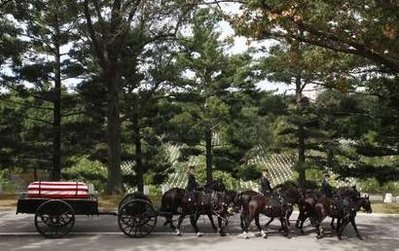
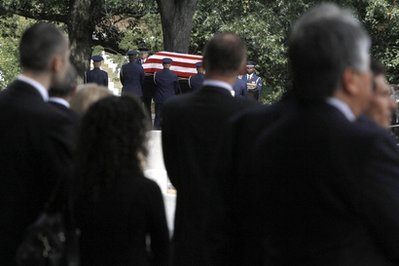

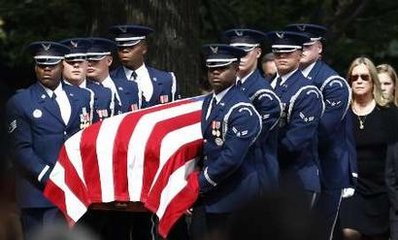
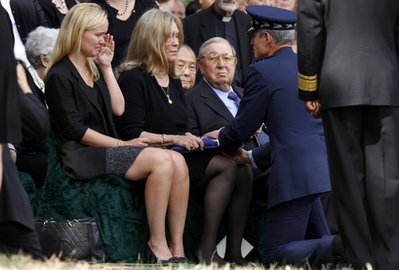
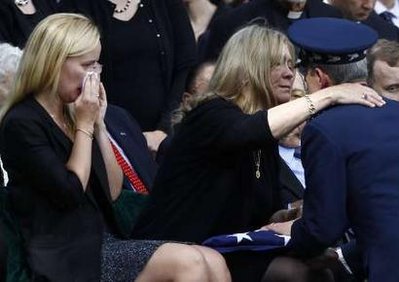
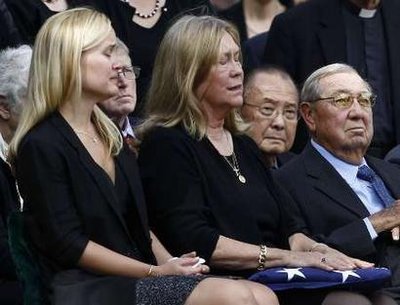
Michael Robert Patterson was born in Arlington and is the son of a former officer of the US Army. So it was no wonder that sooner or later his interests drew him to American history and especially to American military history. Many of his articles can be found on renowned portals like the New York Times, Washingtonpost or Wikipedia.
Reviewed by: Michael Howard

